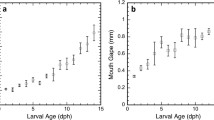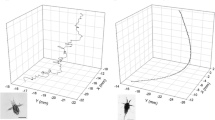Abstract
Herring larvae were obtained via artificial spawning (Baltic spring spawners, Downs herring). Eggs were immediately transported to the Marine Station (“Meeresstation”) of the Biologische Anstalt Helgoland, transferred into 140] tanks, and incubated at about 10°C. Sea water was circulated through an internal filter. Artificial illumination (neon tubes) was kept at about 1000 Lux (water surface) during 12 h per day; it was than decreased gradually to complete darkness within 30 min. Dawn was also simulated in order to avoid abrupt changes in light intensity. Food consisted of wild plankton (mainly crustacean nauplii) caught every day on Helgoland Roads, and of Artemia salina nauplii. The larvae were fed 1 to 3 times a day; they took the food always within the first half hour after it was offered. Over periods of 5 min each, the time spent for various activities (different modes of swimming, feeding) were recorded. The behavioural patterns of comparable larvae were filmed. The initial phase of prey catching consists of s-shaped body bending; usually the main bend of the body (upper arrows in Figs. 2 and 3) bears a typical directional relationship to the swimming path of the prey focussed (lower arrows). Such body bending is not always succeeded by subsequent steps of prey catching. In the normal prey catching process, aiming is followed by sudden stretching of the body and swallowing of the prey within 0.2 to 0.3 sec. Yolk sac larvae can use their pectoral fins, larvae of more then 15 mm total length also their tail- and dorsal-fins, for stabilization and correction of prey catching movements. In yolk sac larvae, complete prey catching lasts about 1 to 3 sec. Percentage successful prey catching manoeuvres increases with age and experience (Table 2). Initial success percentage was about 1% in Baltic Sea larvae (Kiel) and about 10% in Downs larvae; it rose within 30 to 35 days in Kiel larvae to nearly 60%, in Downs larvae to over 70%. The possible reasons for these differences are discussed; they may be related to body size and composition of planktonic food. Visual perception of food depends on optic capacities of larvae, size and distance of prey, visibility, and “duration of presentation” (time span during which the image of the prey is projected onto the retina). This, in turn, appears to be subject to frequency and amplitude of undulating movements of the head during swimming. The percentage of body positioning for prey catching attains maximum values at prey distances of 2 to 8 mm in yolk sac larvae (Downs), and of 3 to 40 mm in larvae of 15 to 20 mm body length; it decreases steadily with increasing prey distance. Larvae up to 15 mm total length take mainly copepod nauplii, larger larvae preferably copepodites. Distance of prey perception is wider in the horizontal than in the vertical plane; in fact, larvae do not perceive prey underneath the horizontal plane.
Zusammenfassung
-
1.
Bei Aufzuchtversuchen mit Heringen Clupea harengus wurde das Beutefangverhalten der Larven untersucht.
-
2.
Heringslarven leiten die Beutefanghandlung mit einem s-förmigen Aufbiegen der Körperachse ein. Diese erfolgt in der Regel entgegen der Schwimmrichtung des Beutetieres. Sie jagen nur selten flüchtenden Planktern nach.
-
3.
Der Blickwinkel des binokularen Gesichtsfeldes ist nicht bei jedem Fixieren gleich und schwankt in der Regel zwischen 35° und 70°.
-
4.
Die Geschwindigkeit der Schnappbewegung nimmt mit der Körperlänge zu. Sie beträgt bei 8 mm-Larven 5 cm/sec, 15 mm-Larven 23 cm/sec und 25 mm-Larven 30 cm/sec.
-
5.
Die Dauer der Beutereaktionen, die mit einer Fanghandlung beendet werden, liegt in der Regel zwischen 1 und 3 sec.
-
6.
Die Treffsicherheit der Fanghandlungen steigt mit dem Erfahrungsalter bei Larven der Kieler Frühjahrslaicher von etwa 1% (Zeitpunkt der ersten Nahrungsaufnahme) auf etwa 60% (30 bis 35 Tage alte Larven) und bei Downslarven von 10% (4 bis 6 Tage alt) auf über 70% (32 bis 33 Tage) an.
-
7.
Die Treffsicherheit wird von der Zusammensetzung des Futterplanktons nach Größe und Art beeinflußt.
-
8.
Die im Wahrnehmungsbereich einer Larve auftauchenden Plankter werden offenbar nicht immer gleich gut gesehen. die Deutlichkeit der Abbildung auf der Retina ist abhängig von der Darbietungszeit. Frequenz und Amplitude der schlängelnden Schwimmbewegung bestimmen die Größe der Sichtfelder, die mit erhöhter Darbietungszeit wahrgenommen werden.
-
9.
In der Regel wird bis zu einem Winkel von 70° seitlich zur Schwimmrichtung auf Beute reagiert; die häufigsten Reaktionen erfolgten zwischen 30° und 50°.
-
10.
Der mittlere Abstand aller Partikel, auf die Heringslarven z. Z. der ersten Nahrungsaufnahme reagieren, läßt sich für Kieler Larven mit 5 mm und für Downslarven mit 7 bis 8 mm angben.
Similar content being viewed by others
Literatur
Baerends, G. P., B. E. Bennema und A. A. Vogelzang: Über die Änderung der Sehschärfe mit dem Wachstum bei Aequidens portalegrensis (Hensel) (Pisces, Cichlidae). Zool. Jb. (Abt. Syst. Ökol. Geogr. Tiere) 88, 67–68 (1960).
Blaxter, J. H. S.: The feeding of herring larvae and their ecology in relation to feeding. Rep. Calif. coop. oceanic Fish. Invest. 10, 79–88 (1965).
—: The effect of light intensity on the feeding ecology of herring. In: Light as an ecological factor, pp 393–409. sEd. by R. Bainbridge, G. C. Evans and D. Rackham. Oxford: Blackwell 1966. (Symp. Br. ecol. Soc. 6.)
— und G. Hempel: Biologische Beobachtungen bei der Aufzucht von Heringsbrut. Helgoländer wiss. Meeresunters. 7, 260–283 (1961).
—: The influence of egg size on herring larvae (Clupea harengus L.). J. Cons. perm. int. Explor. Mer 28, 211–240 (1963).
—: Utilization of yolk by herring larvae. J. mar. biol. Ass. U.K. 46, 219–234 (1966).
— and M. P. Jones: The development of the retina and retinamotore response in the herring. J. mar. biol. Ass. U.K. 47, 677–697 (1967).
Braum, E.: Die ersten Beutefanghandlungen junger Blaufelchen (Coregonus wartmanni Bloch) und Hechte (Esox lucius L.). Z. Tierpsychol. 20, 257–266 (1963).
—: Experimentelle Untersuchungen zur ersten Nahrungsaufnahme und Biologie an Jungfischen von Blaufelchen (Coregonus wartmanni Bloch), Weißfelchen (Coregonus fera Jurine) und Hechten (Esox lucius L.). Arch. Hydrobiol. (Suppl.) Bd 28, 183–244 (1964).
Einsele, W.: Problems of fish larvae survival in nature and the rearing of economically important middle European freshwater fishes. Rep. Calif. coop. oceanic Fish. Invest. 10, 24–30 (1965).
Flüchter, J.: Funktionsanatomische Untersuchungen am Kieferapparat der Heringslarven. Kurze Mitt. Inst. Fisch-Biol. Univ. Hamb. 12, 1012 (1962).
—: Eine besonders wirksame Aquarienfilterung und die Messung ihrer Leistung. Helgoländer wiss. Meeresunters. 11, 168–170 (1964).
Gillbricht, M.: Kolometrische pH-Messung im Seewasser unter Verwendung von Kresolot. Kurze Mitt. fischbiol Abt. Max-Planck-Inst. Meeresbiol. Wilhelmsh. 2, 1–19 (1953).
Gulland, J. A.: Survival of the youngest stages of fish and its relation to year class strength. Spec. Publs int. Commn. NW. Atlant. Fish. 6, 363–372 (1965).
Hempel, G.: On the causes of changes in recruitment. Rapp. P.-v. Réun. Cons. perm. int. Explor. Mer 154, 17–22 (1963).
—: On the importance of larval survival for the population dynamics of marine food fish. Rep. Calif. coop. oceanic Fish. Invest. 10, 13–23 (1965).
— and J. H. S. Blaxter: Egg weight in Atlantic herring (Clupea harengus L.). J. Cons. perm. int. Explor. Mer 31, 170–195 (1967).
Hjort, J.: Fluctuations in the year classes of important food fishes. J. Cons. int. perm. Explor. Mer 1, 5–38 (1926).
Kinne, O. and G. A. Paffenhöfer: Growth and reproduction as a function of temperature and salinity in Clava multicornis (Cnidaria, Hydrozoa). Helgoländer wiss. Meeresunters. 13, 62–72 (1966).
Kuhl, W.: Zur Anwendung des Schmalfilmes (16 mm) in der Zellforsch. Mikroskopie 16, 264–273 (1961).
Lobenz, K.: Über tierisches und menschliches Verhalten. Aus dem Werdegang der Verhaltenslehre. (Ges. Abh. Bd 2), 398 pp. München: Piper 1965.
Müller, H.: Bau und Wachstum der Netzhaut des Guppy (Lebistis reticulatus). Zool. Jb. (Abt. allg. Zool. Physiol. Tiere) 63, 275–324 (1952).
Oppenheimer, C. H. and C. E. Zobell: The growth and viability of sixty-three species of marine bacteria as influenced by hydrostatic pressure. J. mar. Res. 11, 10–18 (1952).
Ricker, W. E.: Stock and recruitment. J. Fish. Res. Bd Can. 11, 559–623 (1954).
Riley, J. D.: Marine fish culture in Britain. 7. Plaice (Pleuronectes platessa L.) Post-larval feeding on Artemia salina nauplii and the effects of varying feeding levels. J. Cons. int. perm. Explor. Mer 30, 204–221 (1966).
Rosenthal, H.: Parasites in larvae of the herring (Clupea harengus L.) fed with wild plankton. Mar. Biol. 1, 10–15 (1967).
—: Beobachtungen über die Entwicklung des Schwarmverhaltens bei den Larven des Herings Clupea harengus. Mar. Biol. 2, 73–76 (1968a).
—: Schwimmverhalten und Schwimmgeschwindigkeit bei den Larven des Herings, Clupea harengus. Helgoländer wiss. Meeresunters. 18, 453–486 (1968b).
—: Verdauungsgeschwindigkeit, Nahrungswahl und Nahrungsbedarf bei den Larven des Herings, Clupea harengus L. Ber. dt. wiss. Kommn Meeresforsch. 20, 60–69 (1969).
Rosenthal, H. and G. Hempel: Experimental studies in feeding and food requirements of herring larvae. In: Symposium on Marine Food Chains, Aarhus, Paper No. 22, 1–22 (1968) (mimeographed).
Schach, H.: Die künstliche Aufzucht von Clupea harengus. Helgoländer wiss. Meeresunters. 1, 359–372 (1939).
Schumann, G. O.: Some aspects of behavior in clupeid larvae. Rep. Calif. coop. oceanic Fish. Invest. 10, 71–78 (1965).
Shelbourne, J. E.: A marine fish-rearing experiment using antibiotics. Nature, Lond. 198, 74–75 (1963).
Strickland, J. H. D. and T. R. Parsons: A manual of sea water analysis ... 2nd ed. Bull. Fish. Res. Bd Can. 125, 1–203 (1965).
Uhlig, G.: Die mehrgliedrige Kultur litoraler Folliculiniden. Helgoländer wiss. Meeresunters. 12, 52–60 (1965).
Author information
Authors and Affiliations
Additional information
Communicated by O. Kinne, Hamburg
Diese Arbeit ist Teil einer unter Leitung von Professor Dr. G. Hempel durchgeführten Dissertation der Mathematisch-Naturwissenschaftlichen Fakultät der Universität Hamburg.
Rights and permissions
About this article
Cite this article
Rosenthal, H. Untersuchungen über das Beutefangverhalten bei larven des herings Clupea harengus . Marine Biology 3, 208–221 (1969). https://doi.org/10.1007/BF00360953
Accepted:
Issue Date:
DOI: https://doi.org/10.1007/BF00360953




